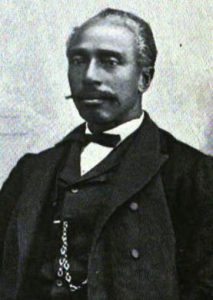William D. Coleman
William David Coleman |
|
| Term | 13th President: 1896 – 1900 |
| Born | July 18, 1842, Fayette County, Kentucky, USA |
| Died | July 12, 1908, Clay-Ashland, Liberia |
| Race/Ethnicity | Americo-Liberian |
| County of Origin | Montserrado |
| Profession | Merchant |
| Political Party | True Whig Party |
Bio
This former president was born in Kentucky, USA and lost his father at a young age. Along with his mother, he and three other family members moved to Liberia in 1853. The family settled in Clay-Ashland which was then called Kentucky. Coleman is described as a poor boy from Kentucky who had to quit school because he had no money.
He worked on a canoe that travelled from the settlement of Kentucky (Clay-Ashland) near the St. Paul River to Monrovia. His early years were filled with hardships, but a frugal and energetic fellow, he advanced from the position of constable, gradually to the House of Representatives. He is seen as channeling the nation’s first president, J.J. Roberts, who in spite of poverty pushed himself and rose to the highest office in the nation.
Education
While working various jobs during his early career, he spent time studying during the evenings and nights. Unlike previous presidents, he was not a college graduate. Nevertheless, he possessed the courage, will and other qualities required for a successful political career.
Career
| – | Canoe Paddler on the St. Paul River |
| – | Carpenter |
| – | Farmer |
| – | Merchant |
| 1877 – 1879 | Representative (Speaker of the House), Montserrado County |
| 1879 – 1891 | Senator, Montserrado County |
| 1892 – 1896 | Vice President under President Cheeseman |
| 1896 – 1900 | President
Vice President |
He was self motivated and had a drive that helped him excel from humble beginnings to eminence. He was a canoe paddler on the St. Paul River, became a carpenter and later a successful merchant before he was elected to the House of Representatives in 1877 and the Senate in 1879. Coleman was Vice President under President Cheeseman and rose to the office of President when Cheeseman died in 1896. He completed Cheeseman’s term that ended in 1898 and was elected President two more times on his own merits.
Presidency
Terms
1896 – 1898 Completed Cheeseman’s term
1898 – 1900
1900 – Resigned on Dec 10, 1900
There were three cornerstones of Coleman’s presidency; namely, education, the economy and the government’s reach into the interior. With the help of Edward Wilmot Blyden, Liberia College was reopened to provide higher education. Annual payment of the 1871 loan began under his leadership and the nation’s bonded warehouse system was created at the six ports of entry were the Europeans traded. This allowed the government to control the flow of imports and exports and prevent abuses.
Coleman believed that government influence on the hinterland would improve the revenue of the nation as interior resources could be exploited. Hence, he extended government control beyond Clay-Ashland into Northwest Liberia and wanted to forcefully subdue the Gola and other tribes under the government’s control. The tribes and many government officials opposed his native policy and it was defeated. According to Waite,
-Waite
He resigned on December 11, 1900. Vice President J.J. Ross had died and since there was no VP at this time, the Legislature decided that Coleman’s successor would be Secretary of State and President elect, Garretson W. Gibson. This was a controversial issue as his legal successor should have been House Speaker Robert H. Marshall.
Post Presidency
He was still involved in Politics and ran for the presidency on the People’s Party Ticket in 1901, 1903 and 1905; but was defeated all three times.
Coleman’s death was announced at 6am on Sunday, July 12, 1908 by the Clay-Ashland Battery (Liberia, Issue 33, ACS). His funeral in Clay-Ashland drew the masses and the Bishop S.D. Ferguson delivered a touching sermon. After the Masons, U.B.F.’s and Mechanic Society performed their burial rites, there followed the military salute and the former President was laid to rest.
Sources
Brawley, Benjamin Griffith. A Social History of the American Negro, Being a History of the Negro Problem in the United States, Including a History and Study of the Republic of Liberia. The Macmillan Company, 1921. Print.
Cassell, Abayomi. Liberia: History of the First African Republic. New York. Fountainhead Publishers, 1970. Print.
Dunn, D. Historical Dictionary of Liberia / D. Elwood Dunn, Amos J. Beyan, Carl Patrick Burrowes. 2nd ed. Lanham, Md.: Scarecrow Press, 2001. Print.
Ex-President William David Coleman Dead, Than Whom a Greater Statesman Lived Not in Liberia. Liberia. Bulletin No. 33. The American Colonization Society. Nov. 1908. Print.
Liberia. American Colonization Society Bulletin No. 10 – 18. Feb. 1898. Print.
Liberia. American Colonization Society Bulletin No. 19-27. Nov. 1905. Print.
Van Der Kraaij, Fred. The Presidents. Liberia’s Past and Present. Web.
Van Der Kraaij, Fred. President William David Coleman 1896 – 1900. Liberia’s Past and Present. Web.
Waite, Philip. 1871 to World War One. Liberia History. Web.
Visits: 362
